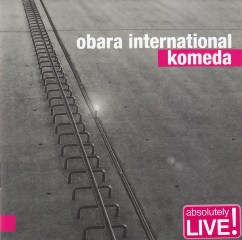Obara International – Komeda (2013)
Obara International – Komeda (2013)

1 Litania 15:19 2 Etiudy Baletowe – Introdukcja 14:52 3 Walter P-38 14:02 4 Kattorna 6:52 5 Komeda's Medley (20:14) 5.1 People Meet And Sweet Music Fills The Heart 5.2 Astigmatic 5.3 Svantetic Alto Saxophone – Maciej Obara Double Bass – Ole Morten Vågan Drums – Gard Nilssen Piano – Dominik Wania
It’s not a secret that Scandinavia has always been a fascination for Polish saxophonist Maciej Obara, especially in recent times when he started to look in his music for the "cooler means of expression". It was therefore a happy coincidence when during the Take Five: Europe meeting in 2012 his musical path crossed with two Norwegians: double bassist Ole Morten Vågan and drummer Gard Nielssen.
His decision to record the music of legendary Krzysztof Komeda seems to be natural. On the one hand Komeda is a point of reference for any jazz musician in Poland and to establish himself on our scene it is mandatory to record his music. Moreover Obara and pianist Dominik Wania were lucky to have some personal connection to Komeda as they both collaborated with Tomasz Stańko, a favourite trumpeter of Komeda, in his New Balladyna Project where they also played some of Komeda’s compositions. The same goes for the “Vikings” who were ready or even keen on to take up a role of some of such illustrious Scandinavian players like Rune Carlsson or Bernt Rosengren who used to appear on some of the most significant Komeda’s recordings.
But let’s go back to the music on this album which comprises five long up to 20-minutes tracks which nonetheless are highly expressive, keeping listener’s attention from very first to last second due to abundance of original ideas and great communication between players. The album begins with "Litania": an impressionistic introduction spreading a palette of "cool" sounds with delicate support by the rhythm section whose selectivity is striking. Dominik Wania in particular, as much here as anywhere else on this album, shows his awesome pianistic potential: his intuition, subtlety, feeling of a form and a certain kind of playfulness are simply beyond a praise.
Next "Etiudy Baletowe-Introdukcja” starts with a energetic drum solo of Gard Nilsen announcing an up-tempo character of this tune. And again our attention turns to Wania who masterfully plays with convention and texture, sounding at times with a blues roughness and occasionally giving also rhythmic puzzles to the bassist. He follows the groove by pushing himself in-between aggressive plucking of doublebass strings with surprising passages, repetitions and harmonic returns which though still firmly in the jazz tradition go beyond it at the same time.
"Walter P-38" is a track from a film etude with the music of Komeda illustrating a detective story. The evocative leitmotif played by Obara exemplifies well his exceptional timbre and expression which astounds me throughout this album. Unlike on his other projects, especially early ones, his tone is fully controlled, aware of what his partners are doing and, the most important of all, it gained this specific, Komeda blues characteristic. Next, another movie track, is a tune from Swedish movie "Kattorna" (“The Cats”, 1965). This tune is feisty and surprisingly courageous as for theme about female love. Like actresses in this film, the music shows predator claws on misleadingly soft creatures, mixing latin rhythms with a hot African beat. Gard Nilsen now in cooperation with his compatriot create a vibrant, fiery base, reminding me of sultry duos of William Parker and Hamid Drake.
The sound of Scandinavia can also be heard in “Komeda’s Medley” featuring bits of “Cages”, “Astigmatic” and “Svantetic” compositions. They are particularly present in airy “Cages” with its unhurried saxophone theme. Then this nostalgic ballad gives place to vigorous "Astigmatic", where the rough melody quickly loops time and again and the band’s music spins like a broken record. Finally “Svantetic” comes (both tunes from the legendary album “Astigmatic”, 1965) and the music is reaching its climax in sophisticated, hardbop solos of all musicians paying their tribute to Komeda’s genius and confirming Maciej Obara’s own words - its a dream team, a powerful trampoline to the international scene. ---Monika Okrój, polish-jazz.blogspot.com
Maciej Obara – bez wątpienia jedna z najjaśniejszych i bardzo docenionych już postaci na dzisiejszej młodej jazzowej scenie – nie złożył swojego artystycznego życia na komedowym ołtarzu. Nie uwikłał się w rozpamiętywanie legendy i pielęgnacje pamięci o niej. Nigdy nie krył, że woli sam brać się za bary z muzyką i swoim charakterem zapisywać jej kolejne rozdziały.
Toteż kiedy organizatorzy V Letniej Akademii Jazzu w Łodzi zwrócili się do niego z propozycją zagrania koncertu z muzyką Komedy, raczej trudno było spodziewać się, że zostawi wszystko i na kilka miesięcy rzuci się w wir rozmyślań nad repertuarem klasyka. Ale post factum przyznać też trzeba, że wcale tego nie musiał robić.
Dziś ma znakomity własny kwartet. W połowie norweski, w połowie polski, w którym grają oprócz Ole Mortena Vågana – kontrabas i Gardana Nilssena – perkusja (skądinąd muzycy zapoznani podczas wyjazdu na stypendium Take Five: Europe), on sam na saksofonie altowym oraz pianista Dominik Wania. I to właśnie zespół wydaje się w całej tej perspektywie przynajmniej równie ważny, co muzyka Komedy. ---empik.com
download (mp3 @320 kbs):
yandex mediafire ulozto gett bayfiles








